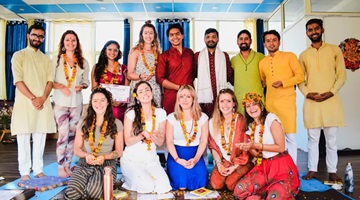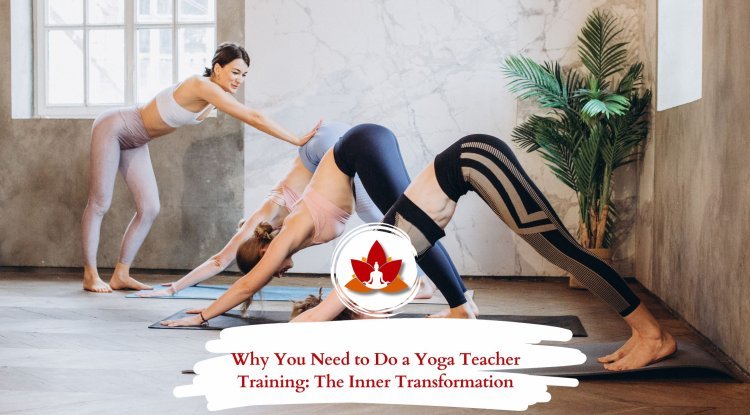Yoga Sutra 1.3: Tada drastuh svarupe vasthanam

Hidden beneath the veil of distractions and the relentless noise of modern life lies the essence of who we truly are. Patanjali’s third sutra gently calls us to peel away these layers—habitual thoughts, emotional clutter, and societal conditioning—to uncover the radiant jewel within.
Yoga Sutra 1.3 tells us that when the fluctuations of the mind are stilled, the true self is revealed. This self is not defined by roles, identities, or external circumstances. It is pure awareness—calm, clear, unchanging.
Like a beacon of light, this sutra illuminates the path to self-realization. It reminds us that beyond the mind's chatter is a quiet, unwavering presence that has always been there—whole, luminous, and free.
In simple terms, when the mind becomes still, you meet your true self—not as a concept, but as a living, felt experience of deep peace and inner clarity.
What is Yoga Sutra 1.3?
This profound sutra offers a glimpse into the heart of yogic practice. It tells us what happens once the fluctuations of the mind (vrittis) are stilled—the central focus of Sutra 1.2. When the mental chatter settles and the waves of thought come to rest, the practitioner is no longer entangled in the distractions of the outer world or the turbulence of inner narratives.
In this silence, the seer—the pure Self—emerges. Not a new self, but the one that has always been there beneath the surface: steady, radiant, and untouched by the movements of the mind.
This state of unmixed awareness is yoga’s promise. But reaching it is not simple. It asks us to:
-
Move beyond mental restlessness
-
Transcend constant distraction
-
Let go of the false identities shaped by ego—those stories and roles we cling to out of habit or fear
These illusions cloud our perception, preventing us from seeing clearly. Yoga, as Patanjali defines it, is the path of gently releasing those veils so we can abide in our true nature—not just during meditation, but in every moment of life.
Yoga Sutra 1.3 Translation
Sanskrit word : तदा द्रष्टुः स्वरूपेऽवस्थानम्॥३॥
Translation: Tadā draṣṭuḥ svarūpe'vasthānam
Word for word translation:
• tadā = then or only after, implying that this state is reached after the stopping of mental fluctuations (vṛttis).
• draṣṭuḥ = the pure consciousness, the soul, the seer, or the true self who sees without being affected.
• sva = own
• rūpe = color, form, nature
• avasthānam = rests, abides
Ancient and Modern Interpretations of Sutra 1.3:
What is the nature of Puruṣa—the true Self, the Seer—when the mind becomes completely still and buddhi (intellect) perceives nothing?
Vyāsa, the earliest and most authoritative commentator on the Yoga Sutras, explains that in this state, pure consciousness abides in itself, just as it does in the state of liberation (kaivalya). When all mental fluctuations (vrittis) are brought to a complete standstill, the mind dissolves, never to return. This is the ultimate state of kaivalya—absolute freedom and isolation of the Self from all identification with the mind.
However, in nirodha—the temporary cessation of mental activity—the mind is merely paused, not permanently eradicated. Still, during this interval of silence, the Seer (Puruṣa) rests in its own nature (svarūpa), undisturbed by thought or sensory input. This, according to Vyāsa, is a reference not just to the Seer’s eternal nature, but to the state of the mind when it no longer projects or distorts reality.
Modern scholars like I.K. Taimni describe this experience as Self-realization—the direct perception of one's true nature beyond thought, emotion, and identity. But because we are so entangled in the ongoing drama of the mind’s fluctuations (cittavṛttis), we seek understanding through the intellect, which can only take us so far.
The truth of Sutra 1.3 can only be fully grasped through inner experience, not outer analysis. It is not something to be understood from the outside looking in—but rather, something to be realized within, in the stillness where the mind ends and the Self begins.
The Path of Self-realization
Yoga Sutra 1.3 outlines a profound journey inward—the path of Self-realization—a process rooted in meditation, self-inquiry, devotion, and detachment. This is not an easy path. It requires consistent effort, because the mind’s vrittis—its habitual patterns of thought, emotion, and perception—are deeply ingrained.
These mental fluctuations bind us to a limited identity, shaped by external circumstances, societal roles, and the need for approval. Over time, this identification veils our true nature, making it difficult to recognize the deeper Self.
But when we begin to identify with the draṣṭuh—the Seer, the silent witness within—we shift our perspective. We no longer define ourselves by the fleeting nature of thoughts and feelings. Instead, we begin to anchor in the eternal presence that underlies them.
This process is much like watching a stormy sea settle into stillness. As the waves quiet, the depths become visible. Similarly, when the mind calms, a natural clarity emerges—and in that calm, the true Self is revealed.
Here, pure consciousness shines through—untouched by mental distortion, emotional reactivity, or ego-based narratives. This is the heart of yoga: not to become something new, but to return to what you’ve always been.
The Journey of Letting Go
Attachments—to possessions, relationships, outcomes, and sensory pleasures—cloud our inner vision and anchor us to the egoic self. These clinging patterns keep us tethered to fear, desire, and identity, making it harder to see who we truly are.
In yogic philosophy, the cultivation of vairāgya—detachment—is essential for quieting the mind and softening the grip of these attachments. It is not about renouncing the world, but about releasing the illusion that our self-worth depends on it.
When we let go of external attachments, we free ourselves from the emotional highs and lows that arise from gaining or losing. We begin to rest in a sense of wholeness that isn’t shaken by impermanence.
Attachments create a cycle of craving and discontent. But vairāgya breaks this cycle, allowing us to engage with life from a place of inner freedom. It doesn’t make us cold or indifferent—it allows us to be more present, more compassionate, and more at peace amid life’s inevitable ups and downs.
Detachment is not disconnection—it is the path to true connection with the Self.
Benefits of Realizing the True Self
When the mental clutter quiets and you enter a state of pure awareness, profound shifts begin to unfold. Realizing your True Self isn’t just a lofty spiritual goal—it transforms how you see the world, relate to others, and move through life. Here are some of the most powerful benefits:
1. Inner Peace
Self-realization brings a deep and lasting sense of peace. When the mind is no longer tormented by endless thoughts and judgments, clarity emerges. This inner calm empowers you to face life’s challenges with steadiness and grace, rooted in the knowledge that you are more than your passing thoughts and emotions.
2. Emotional Resilience
Recognizing the separation between the observer (the Self) and the observed (emotions, thoughts) fosters emotional strength. You begin to see emotions as temporary waves, not permanent truths. This space allows for mindful responses instead of reactive behavior—you respond, rather than react.
3. Greater Clarity and Concentration
As mental turbulence quiets, the mind becomes clear and focused. Your ability to concentrate improves, enhancing decision-making, creativity, and problem-solving. In stillness, solutions often arise effortlessly—free from the noise of overthinking.
4. Deeper Connections
When the ego loosens its grip, compassion, empathy, and authenticity naturally arise. You no longer seek validation or act out of insecurity. Instead, you relate to others from a space of genuine understanding, which deepens relationships and dissolves conflict born of egoic misunderstanding.
5. Authentic Living
Realizing your True Self allows you to live with integrity and truth. Your actions align with your inner values, not external expectations. You become less driven by people-pleasing and more attuned to your purpose. This alignment brings deep joy and fulfillment, as you express yourself freely and fearlessly.
6. Spiritual Growth
At its core, Self-realization is the engine of spiritual evolution. As the fluctuations of the mind subside and your true nature shines through, you naturally connect with higher states of consciousness. Inner wisdom begins to guide you, leading to profound spiritual insight and transformation.
Living Sutra 1.3 on the Mat
At Rishikesh Yogkulam, we believe that yoga is much more than physical postures—it is a journey inward. Sutra 1.3, "Tadā draṣṭuḥ svarūpe'vasthānam", reminds us that when the mind becomes still, we return to our true nature.
Here’s how you can embody this teaching during your practice:
Start with Stillness
Begin each class by creating space for presence. Whether through breath awareness, gentle centering, or a short meditation, take a moment to transition from the outer world to your inner sanctuary.
Move with Awareness
Let each asana be a mirror of your inner experience. Move consciously, observing the breath, sensations, and mental activity. Release judgment, comparison, and distraction. Let the practice become a moving meditation, where awareness leads and the body follows.
Contemplate in Savasana
In your final rest, allow yourself to fully surrender into stillness. This is the moment where the Seer (draṣṭuḥ) can shine through—free from effort, free from noise. Use this time to reconnect with your essence, your unshaken center.
Yoga becomes truly transformative when we carry the wisdom of the sutras from the page to the practice, from the mat into life. Sutra 1.3 invites you to not just practice yoga—but to embody it.
Applying Sutra 1.3 to Everyday Life
Yoga Sutra 1.3—"Then the seer abides in its own true nature"—is not just a philosophy for the mat; it’s a guide for how to live with awareness, presence, and authenticity every day.
Here are a few simple yet powerful ways to embody this teaching in daily life:
1. Stop and Breathe
When life feels overwhelming or noisy, pause and take a few deep breaths. Even just 60 seconds of conscious breathing can calm the mind and reconnect you to the present moment. In that stillness, the Seer within has space to shine through.
2. Journal Your Thoughts
Writing helps you observe your mind’s patterns instead of being consumed by them. By journaling regularly, you begin to notice recurring thoughts, worries, or emotional loops—and that awareness is the first step toward freedom.
3. Practice Gratitude
Gratitude brings the mind into the now and shifts your perspective from lack to abundance. Taking a moment each day to reflect on what you’re thankful for helps you anchor in your true self, rather than in fleeting desires or comparisons.
These small practices cultivate moments of clarity amid the busyness of life—moments where you remember that you are not your thoughts, roles, or emotions, but the one who witnesses them all.
A Way to Find Inner Peace
Yoga Sutra 1.3 reminds us that yoga is not about achieving the “perfect” pose—it’s about creating space to reconnect with your inner truth. At Rishikesh Yogkulam, we honor this deeper purpose by offering not just classes, but a supportive community rooted in self-awareness, stillness, and spiritual growth.
Whether you're stepping onto the mat for the very first time or deepening a lifelong practice, let this sutra be your gentle guide—a call to turn inward, to slow down, and to witness the quiet beauty of your true self.
If you’re ready to explore yoga beyond just the physical…
If you’re seeking peace, presence, and purpose...
Join us at Rishikesh Yogkulam and begin your journey inward—toward stillness, authenticity, and the essence of who you truly are.
What's Your Reaction?


























